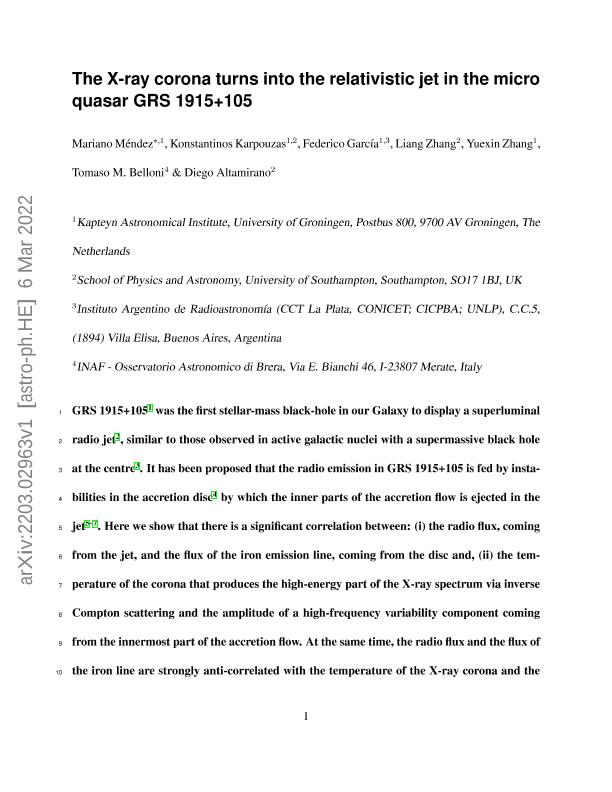Artículo
Coupling between the accreting corona and the relativistic jet in the microquasar GRS 1915+105
Méndez, Mariano; Karpouzas, Konstantinos; García, Federico ; Zhang, Liang; Zhang, Yuexin; Belloni, Tomaso M.; Altamirano, Diego
; Zhang, Liang; Zhang, Yuexin; Belloni, Tomaso M.; Altamirano, Diego
 ; Zhang, Liang; Zhang, Yuexin; Belloni, Tomaso M.; Altamirano, Diego
; Zhang, Liang; Zhang, Yuexin; Belloni, Tomaso M.; Altamirano, Diego
Fecha de publicación:
03/2022
Editorial:
Nature Research
Revista:
Nature Astronomy
e-ISSN:
2397-3366
Idioma:
Inglés
Tipo de recurso:
Artículo publicado
Clasificación temática:
Resumen
Accreting black holes emit highly collimated radio jets expanding at speeds approaching light speed. Some of these jets appear to be expanding at superluminal speeds due to geometric effects. While magnetic fields are thought to be responsible for collimating the ejecta, the mechanism that accelerates the material in these jets remains unexplained. For the galactic black hole GRS 1915+105 with a superluminal radio jet, it has been proposed that thermal instabilities in the accretion disk lead to the ejection of the inner parts of the disk into the jet. Here we use X-ray and radio observations over a 10-year period to reveal a strong correlation between (i) the radio flux that comes from the jet and the flux of the iron emission line that comes from the disk and (ii) the temperature of the hard X-ray corona and the amplitude of a high-frequency variability component that comes from the innermost part of the accretion flow. At the same time, the radio flux and the flux of the iron line are strongly anti-correlated with the temperature of the X-ray corona and the amplitude of the high-frequency variability component. Our findings show that the energy that powers this black hole system can be directed in different proportions either mainly to the X-ray corona or to the jet. These facts, plus our modelling of the variability in this source, suggest that in GRS 1915+105 the X-ray corona turns into the jet.
Palabras clave:
X-rays: individual: GRS 1915+105
Archivos asociados
Licencia
Identificadores
Colecciones
Articulos(IAR)
Articulos de INST.ARG.DE RADIOASTRONOMIA (I)
Articulos de INST.ARG.DE RADIOASTRONOMIA (I)
Citación
Méndez, Mariano; Karpouzas, Konstantinos; García, Federico; Zhang, Liang; Zhang, Yuexin; et al.; Coupling between the accreting corona and the relativistic jet in the microquasar GRS 1915+105; Nature Research; Nature Astronomy; 6; 3-2022; 577–583
Compartir
Altmétricas



